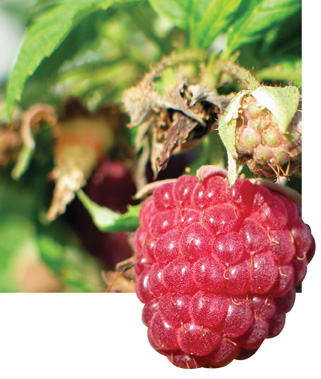
Features
Production
Research
Greenhouse raspberry production Ontario-style
production Ontario-style
March 15, 2008 By Dan Woolley
Doug Balsillie is a horticultural
pioneer, joining the ranks in 1999 when he diversified his production
and started growing greenhouse raspberries after the retail market for
his peaches went soft.
 Doug Balsillie is a horticultural pioneer, joining the ranks in 1999 when he diversified his production and started growing greenhouse raspberries after the retail market for his peaches went soft.
Doug Balsillie is a horticultural pioneer, joining the ranks in 1999 when he diversified his production and started growing greenhouse raspberries after the retail market for his peaches went soft.
Balsillie is blessed with a lengthy growing season and mild winters at his farm in Harrow, Ont., considered on of mainland Canada’s most southerly points. Those growing conditions paid off in 2005 when Balsillie harvested six crops of raspberries during his greenhouse’s seven months of production.
Living close to the U.S. border and the state of Michigan while operating in the midst of the heavily populated Southern Ontario market, Balsillie targets his production for the tourist season, which runs from early May to early November. He sells from a roadside stand at the end of his lane, marketing the best 20 per cent of his berries and earning $1.25 per clamshell in the spring and $2.75 per clamshell in the fall.
Balsillie stores his potted canes in his greenhouse over the winter, turning the heat on about February. This gives him about 90 to 100 days until his first harvest, set for around May 10, which is when the first tourists will begin stopping at his stand.
He keeps his greenhouse temperature during the day at 17ÞC and 10ÞC at night to protect the roots of his canes, however, he has found during the summer heat is a problem in his greenhouse.
Balsillie plants three canes per pot, tying them to a greenhouse overhead. He then pinches back the canes when they reach 12-inches in order to keep them under control. He repeats the pinch-back process as required, “to hold them back and keep them out of the crop,” adding it also makes the pots easier to move out of the greenhouse to the adjacent pot yard
Balsillie pollinates the canes using bumblebees between April 1 and 10, which is when the canes begin to flower. “They are wonderful pollinators,” he says. “They are very gentle. You can work around them and they will work in low temperatures.”
Following his last harvest of spring berries, Tulameen, usually around July 10, Balsille cuts off the fruiting canes and moves the pots to the pot yard where they are tied to a temporary
trellis. The fall berry pots, Autumn Britten, are then moved into the greenhouse. They will produce until about November 1. Easy movement of the crop is essential, he says, adding roll-up greenhouse sides are a big benefit and convenience.
Following his final harvest in November, Balsillie stores all his spring and fall raspberry pots in apple bins within the greenhouses. The pots are changed every four years, a lesson he learned after yield dropped in 2005. However, he does plan to repot the healthy canes.
his nutrient program, Balsillie injects Triple 20 fertilizer into his greenhouse water system at concentrations of 100 ppm until flowering, dropping it to 50 ppm until fruiting.
Pest control is an important aspect of his production system. While multi-coloured Asian ladybeetles (MALB) are becoming an issue in his operation, Balsillie says spider mites are his biggest pest problem. He urges growers to be vigilant for them. “When you start to see a problem with spider mites, it is too late.”
In light of this, he sprays all of his canes for spider mite as soon as they reach the four to five inch stage. He also uses a predator mite, Phytoseuilus persimiles, which cost $70 to $80 per unit. “You need to introduce it early,” he advises.
Birds became an unexpected pest for Balsillie, who now drapes nets over his greenhouses. However, marauding raccoons quickly tore the netting and because of their nearby presence, Balsillie began to feel he could not longer leave his roadside fruit stand unattended over night. “Fortunately, they had a car accident at the end of our road before we could do anything.”
While he hasn’t had a need to control botrytis in his greenhouses, Balsillie does use Nova as a spot treatment to control powdery mildew, a condition caused by poor ventilation. He also recommends the granular herbicide, Devunal, for orchard weeds.
Despite his enviable southern location, Balsillie feels producers in cooler locations of Canada could do a better job growing greenhouse raspberries than Ontario growers like himself. While his southerly location results in a lot more BTUs, raspberries are ultimately a cool climate crop.
“We don’t get the yield (a cooler location would) because of the heat.”
Print this page